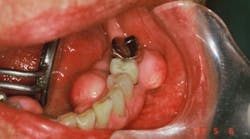Minimally invasive techniques are the future of TMJ treatment: What an oral and maxillofacial surgeon has to say
November is TMJ Awareness Month. According to the Temporomandibular Joint Association, upwards of 35 million Americans may be suffering from TMJ, with 85% of people diagnosed with a temporomandibular joint disorder (TMD) experiencing additional forms of chronic and nonchronic pain. However, the number of people living with TMDs may be exponentially higher than we think, as this condition is under-researched and often misunderstood.1
With a widespread lack of education from both the public and health-care professionals, patients with TMDs do not always receive effective treatment—or any treatment at all.1 Therefore, it is critical to learn how to not only recognize the symptoms of TMJ but understand the array of treatment options to suit each patient's unique needs.
Approaches for TMJ treatment
Although TMJ can be treated with big "sledgehammer" procedures like surgery, the National Institutes of Health recommends a conservative approach-one that does not invade the tissues of the face, jaw, or teeth. Justin P. Richer, DMD, is a maxillofacial surgeon at Riverside Oral Surgery in New Jersey who believes the future of TMJ treatment lies in emerging minimally invasive treatment options.
Below is a conversation with Dr. Richer exploring TMJ treatment options that may be able to provide patients with permanent relief without the risk, commitment, or hefty price tag that comes along with surgery.
Insight from a maxillofacial surgeon
What treatment options are available right now?
"Between night guards (occlusal appliances) and full open-joint surgery, there's now a growing group of minimally invasive TMJ procedures. We can flush the joint (arthrocentesis) to remove inflammation, inject PRP or hyaluronic acid, or even use a small scope to visualize and treat directly. These are low-downtime options that can really help the right patients."
What specific types of minimally invasive TMJ treatments are growing in popularity?
"The most popular minimally invasive TMJ treatments today tend to be neurotoxin (i.e., Botox) injections into the muscles of the face. However, patients should not mistake popularity for effectiveness. These injections primarily help mask symptoms by reducing muscle pain and tension, but they do not directly treat the underlying cause of the disorder.
Some of the most effective minimally invasive treatments are procedures like arthrocentesis, arthroscopy, and injection of PRP into the joint, which aim to directly reduce inflammation within the joint itself. These approaches are more treatment-focused and often provide better long-term results.
Typically, outcomes improve even further when these procedures are combined with traditional therapies such as custom TMJ orthotics designed specifically for the patient's teeth."
Are there particular types of patients who benefit most from these procedures?
"Patients with intra articular adhesions, acute TMJ inflammation, or sudden limitations in mouth opening tend to benefit most from procedures such as arthrocentesis in combination with appliance therapy. These approaches directly address the inflammatory response in the joint and can therefore provide rapid improvement.
Patients who exhibit muscular hypertrophy or myofascial pain can gain additional relief from adjunctive treatments like neurotoxin injections, which help reduce muscle overactivity and associated discomfort."
What does prep and recovery look like for these procedures?
"For procedures like neurotoxin therapy, preoperative preparation is minimal, and postoperative care is typically limited to avoiding rubbing the treated area, remaining upright for about four hours, and avoiding exercise for 24 hours.
Similarly, procedures such as arthrocentesis and arthroscopy require very little preoperative preparation. Postoperative care usually involves mild soreness for a few days and, at most, taking a day off from work."
What do you see for the future of minimally invasive alternatives?
"The future is very bright for minimally invasive TMJ procedures, but what's truly exciting isn't just the potential advancement of technology, but rather the growing ability to properly educate the next generation of providers. By teaching dental students and young clinicians accurate diagnosis, comprehensive assessment, and appropriate case selection, we can significantly improve their ability to identify which patients will benefit most from these treatments. That foundation is what will ultimately drive better outcomes for TMJ care."
Reference
-
TMJ basics. Temporomandibular Joint Association. https://tmj.org/living-with-tmj/basics/
About the Author

Sarah Butkovic, MA, BA
Sarah Butkovic, MA, BA, is an Associate Editor at Endeavor Business Media, where she works on creating and editing engaging and informative content for today's leading online dentistry publications. She holds a Master's English Language and Literature from Loyola University Chicago and is passionate about producing high-quality content that educates, inspires, and connects with readers.


